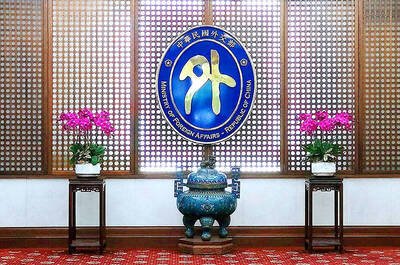Butterfly orchid producers have introduced radio frequency identification (RFID) technology in a move that is expected to raise productivity, agricultural researchers said on Thursday.
As competition in the global orchid market becomes increasingly fierce, research fellows at the Taiwan Agriculture Research Institute said the nation needs to introduce new technology to sharpen its competitive edge in the sector.
Saying that RFID is a powerful emerging technology that enables companies to keep better track of their assets, tools and inventories, the researchers said introduction of the technology to the orchid business will help improve the accuracy of order delivery dates and quantities, thereby increasing customer satisfaction.
If RFID technology is integrated with other automated production and management systems, local orchid productivity could also be raised significantly, the researchers said.
Saying that orchid cultivation — and butterfly orchids in particular — plays a very important role in the nation’s agricultural sector, an official from the Council of Agriculture’s (COA) Taiwan Agriculture Research Institute said Taiwan must pull out all the stops to breed new orchid hybrids and develop new cultivation know-how to maintain its market niche.
The latest statistics released by the council show Taiwan’s flower acreage totals about 13,475 hectares, with an annual production value of about NT$12.36 billion (US$374 million).
The figures account for only about 1.78 percent of Taiwan’s total agricultural production acreage and 7.34 percent of the total annual farming production value, respectively.
Despite the relatively small share of horticulture in terms of acreage and total production value, the official said the unit production value in the sector is about NT$918,000 per hectare.
Among the various floral species cultivated commercially, orchid farms cover about 592 hectares, but their combined annual production value amounts to NT$2.874 billion, representing a unit production value of NT$4.86 million per hectare and indicating that orchids are a high-yielding cash crop.
In comparison, butterfly orchids occupy an even more central role in terms of economic advantage. Butterfly orchids account for only 33.8 percent of the total orchids farmed but export value accounts for 75.2 percent of the total orchid production value.
These figures signify the importance of breeding new butterfly orchid cultivars and developing new cultivation technologies, the official said.
Through years of strenuous efforts, Taiwan has managed to develop greenhouses that suit the nation’s climatic conditions and has established a cultivation system that can ensure perennial blooming of orchids, the official said.
While local butterfly orchid production acreages and values have continued to increase, with Japan and the US serving as the principal export markets, the official said locally produced orchids have been facing ever fiercer competition from the Netherlands, China and Southeast Asia in recent years.
Against this backdrop, the official said, continued quality improvement and upgrading of productivity has become very important in the effort to sustain Taiwan’s butterfly orchid industry.

The Ministry of Foreign Affairs (MOFA) yesterday voiced dissatisfaction with the Comprehensive and Progressive Agreement for Trans- Pacific Partnership (CPTPP), whose latest meeting, concluded earlier the same day, appeared not to address the country’s application. In a statement, MOFA said the CPTPP commission had "once again failed to fairly process Taiwan’s application," attributing the inaction to the bloc’s "succumbing to political pressure," without elaborating. Taiwan submitted its CPTPP application under the name "Separate Customs Territory of Taiwan, Penghu, Kinmen and Matsu" on Sept. 22, 2021 -- less than a week after China

THE GOOD WORD: More than 100 colleges on both sides of the Pacific will work together to bring students to Taiwan so they can learn Mandarin where it is spoken A total of 102 universities from Taiwan and the US are collaborating in a push to promote Taiwan as the first-choice place to learn Mandarin, with seven Mandarin learning centers stood up in the US to train and support teachers, the Foundation for International Cooperation in Higher Education of Taiwan (FICHET) said. At the annual convention of the American Council on the Teaching of Foreign Languages held over the weekend in New Orleans, Louisiana, a Taiwan Pavilion was jointly run by 17 representative teams from the FICHET, the Overseas Community Affairs Council, the Steering Committee for the Test of Proficiency-Huayu, the

A home-style restaurant opened by a Taiwanese woman in Quezon City in Metro Manila has been featured in the first-ever Michelin Guide honoring exceptional restaurants in the Philippines. The restaurant, Fong Wei Wu (豐味屋), was one of 74 eateries to receive a “Michelin Selected” honor in the guide, while one restaurant received two Michelin stars, eight received one star and 25 were awarded a “Bib Gourmand.” The guide, which was limited to restaurants in Metro Manila and Cebu, was published on Oct. 30. In an interview, Feng Wei Wu’s owner and chef, Linda, said that as a restaurateur in her 60s, receiving an

Kaohsiung Mayor Chen Chi-mai (陳其邁) on Monday announced light shows and themed traffic lights to welcome fans of South Korean pop group Twice to the port city. The group is to play Kaohsiung on Saturday as part of its “This Is For” world tour. It would be the group’s first performance in Taiwan since its debut 10 years ago. The all-female group consists of five South Koreans, three Japanese and Tainan’s Chou Tzu-yu (周子瑜), the first Taiwan-born and raised member of a South Korean girl group. To promote the group’s arrival, the city has been holding a series of events, including a pop-up